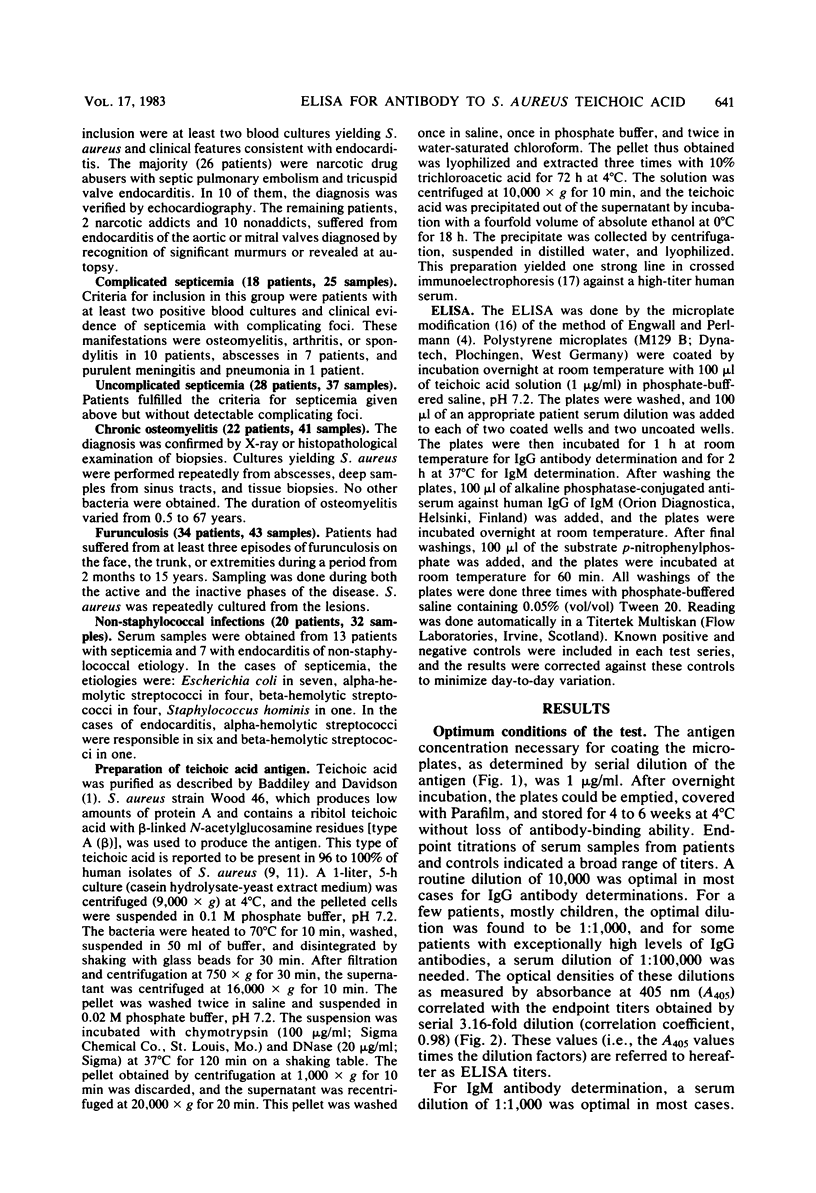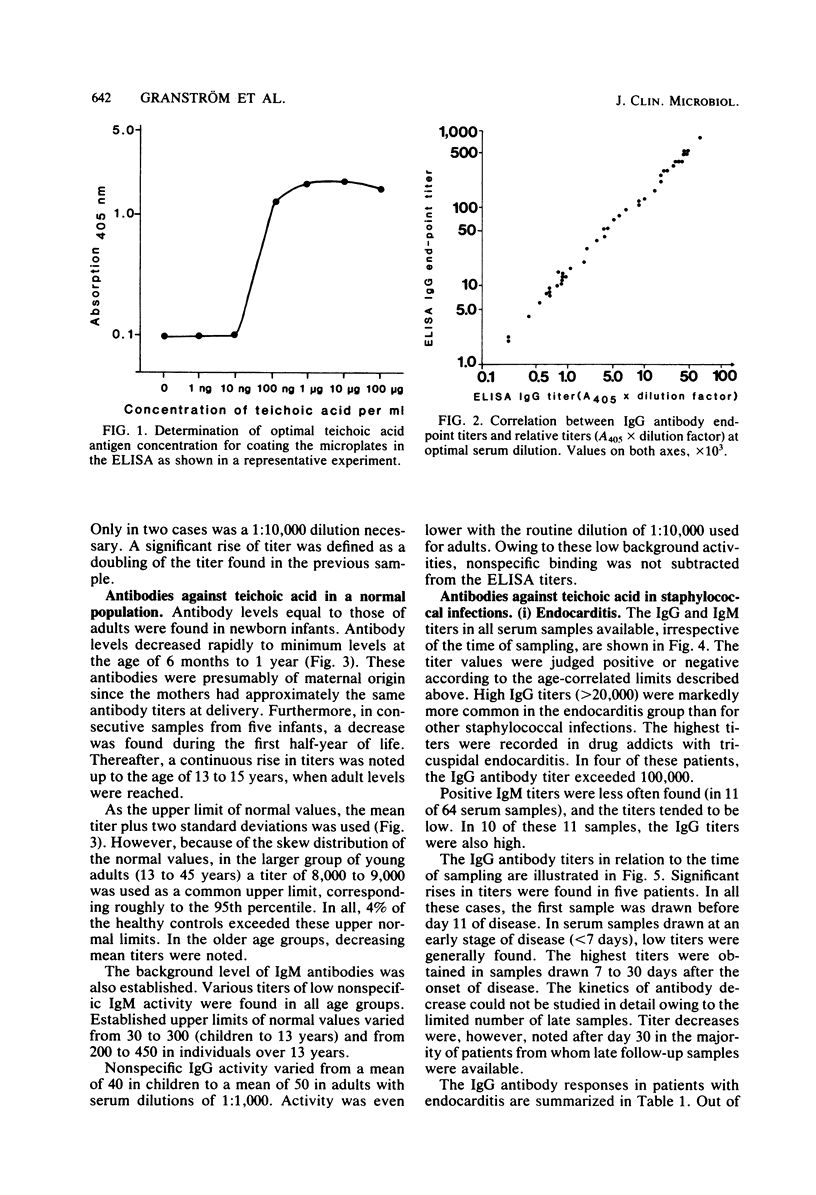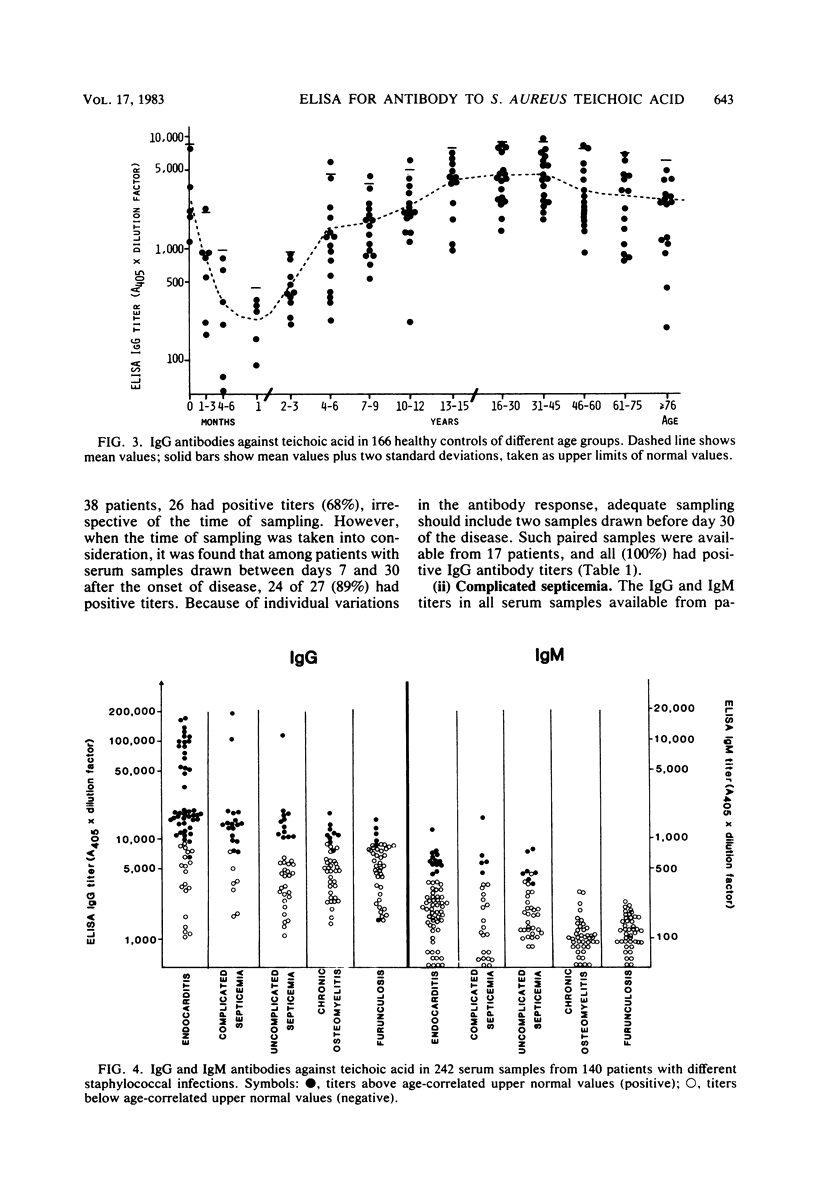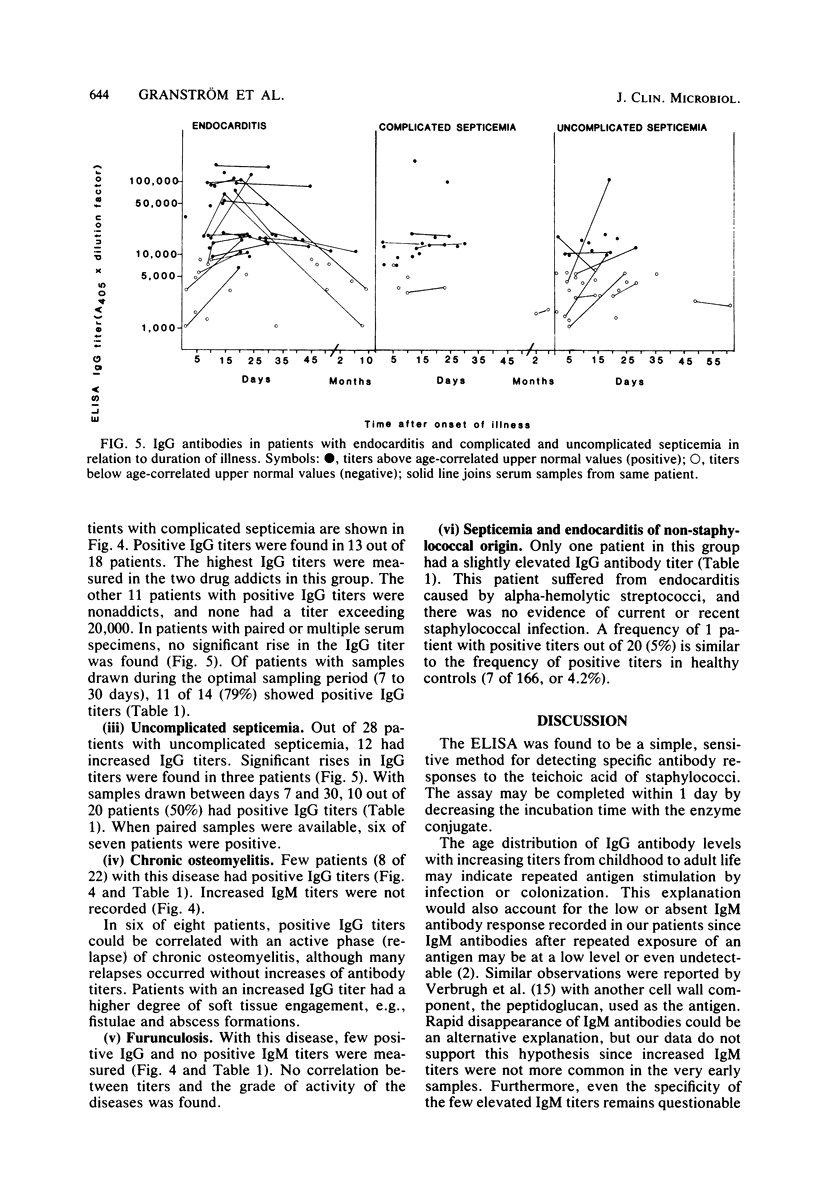Abstract
A highly purified teichoic acid preparation was used in an enzyme-linked immunosorbent assay to measure the specific immunoglobulin G (IgG) and IgM response in staphylococcal disease. Antibody determination in a normal population, showing a difference of up to 20-fold in the mean IgG titers between the youngest children and adults, was used to establish age-correlated upper normal values. IgM antibodies were found to be of little diagnostic value since their response was often low or absent. Increased IgG titers were found in 24 of 27 (89%) patients with endocarditis, in 11 of 14 (79%) with complicated septicemia, and in 10 of 20 (50%) with uncomplicated septicemia with serum samples drawn between days 7 and 30 of disease. With paired samples, the numbers of patients with increased IgG titers were 17 of 17, 3 of 4, and 6 of 7, respectively, in the same patient groups. Increased IgG titers were less often demonstrated in patients with chronic osteomyelitis (7 of 22). The enzyme-linked immunosorbent assay for teichoic acid antibodies was found to be a sensitive and specific method for diagnosing staphylococcal endocarditis and septicemia. For optimal results, both the substantial age-correlated variation in normal titers and the importance of adequately spaced samples should be considered.
Full text
PDF






Selected References
These references are in PubMed. This may not be the complete list of references from this article.
- BADDILEY J., DAVISON A. L. The occurrence and location of teichoic acids in lactobacilli. J Gen Microbiol. 1961 Feb;24:295–299. doi: 10.1099/00221287-24-2-295. [DOI] [PubMed] [Google Scholar]
- Crowder J. G., White A. Teichoic acid antibodies in staphylococcal and nonstaphylococcal endocarditis. Ann Intern Med. 1972 Jul;77(1):87–90. doi: 10.7326/0003-4819-77-1-87. [DOI] [PubMed] [Google Scholar]
- Hedström S. A. General and local antibiotic treatment of chronic osteomyelitis. Scand J Infect Dis. 1969;1(3):175–180. [PubMed] [Google Scholar]
- Jackson L. J., Sottile M. I., Aguilar-Torres F. G., Dee T. H., Rytel M. W. Correlation of antistaphylococcal antibody titers with severity of staphylococcal disease. Am J Med. 1978 Apr;64(4):629–633. doi: 10.1016/0002-9343(78)90583-1. [DOI] [PubMed] [Google Scholar]
- Mackowiak P. A., Smith J. W. Teichoic acid antibodies in chronic staphylococcal osteomyelitis. Ann Intern Med. 1978 Oct;89(4):494–496. doi: 10.7326/0003-4819-89-4-494. [DOI] [PubMed] [Google Scholar]
- Martin R. R., Daugharty H., White A. Staphylococcal antibodies and hypersensitivity to teichoic acids in man. Antimicrob Agents Chemother (Bethesda) 1965;5:91–96. [PubMed] [Google Scholar]
- Nagel J. G., Sheagren J. N., Tuazon C. U., Cardella T. A. Teichoic acids in pathogenic Staphylococcus aureus. J Clin Microbiol. 1977 Sep;6(3):233–237. doi: 10.1128/jcm.6.3.233-237.1977. [DOI] [PMC free article] [PubMed] [Google Scholar]
- Nagel J. G., Tuazon C. U., Cardella T. A., Sheagren J. N. Teichoic acid serologic diagnosis of staphylococcal endocarditis. Use of gel diffusion and counterimmunoelectrophoretic methods. Ann Intern Med. 1975 Jan;82(1):13–17. doi: 10.7326/0003-4819-82-1-13. [DOI] [PubMed] [Google Scholar]
- Oeding P. Wall teichoic acids in animal Staphylococcus aureus strains determined by precipitation. Acta Pathol Microbiol Scand B Microbiol Immunol. 1973 Jun;81(3):327–336. doi: 10.1111/j.1699-0463.1973.tb02211.x. [DOI] [PubMed] [Google Scholar]
- Reimer C. B., Black C. M., Phillips D. J., Logan L. C., Hunter E. F., Pender B. J., McGrew B. E. The specificity of fetal IgM: antibody or anti-antibody? Ann N Y Acad Sci. 1975 Jun 30;254:77–93. doi: 10.1111/j.1749-6632.1975.tb29159.x. [DOI] [PubMed] [Google Scholar]
- Tuazon C. U., Sheagren J. N., Choa M. S., Marcus D., Curtin J. A. Staphylococcus aureus bacteremia: relationship between formation of antibodies to teichoic acid and development of metastatic abscesses. J Infect Dis. 1978 Jan;137(1):57–62. doi: 10.1093/infdis/137.1.57. [DOI] [PubMed] [Google Scholar]
- Verbrugh H. A., Peters R., Rozenberg-Arska M., Peterson P. K., Verhoef J. Antibodies to cell wall peptidoglycan of Staphylococcus aureus in patients with serious staphylococcal infections. J Infect Dis. 1981 Jul;144(1):1–9. doi: 10.1093/infdis/144.1.1. [DOI] [PubMed] [Google Scholar]
- Voller A., Bidwell D., Huldt G., Engvall E. A microplate method of enzyme-linked immunosorbent assay and its application to malaria. Bull World Health Organ. 1974;51(2):209–211. [PMC free article] [PubMed] [Google Scholar]
- WILLIAMS R. C., Jr, KUNKEL H. G. Rheumatoid factor, complement, and conglutinin aberrations in patients with subacute bacterial endocarditis. J Clin Invest. 1962 Mar;41:666–675. doi: 10.1172/JCI104523. [DOI] [PMC free article] [PubMed] [Google Scholar]
- Weeke B. Crossed immunoelectrophoresis. Scand J Immunol Suppl. 1973;1:47–56. doi: 10.1111/j.1365-3083.1973.tb03778.x. [DOI] [PubMed] [Google Scholar]
- Wheat L. J., Kohler R. B., White A. Solid-phase radioimmunoassay for immunoglobulin G Staphylococcus aureus antibody in serious staphylococcal infection. Ann Intern Med. 1978 Oct;89(4):467–472. doi: 10.7326/0003-4819-89-4-467. [DOI] [PubMed] [Google Scholar]


